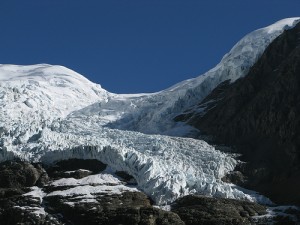Today is Earth Day and it seems appropriate to include an article about climate change.
Last week a study was published in Nature Geoscience showing that some areas of the Himalayas were gaining ice steadily. The study compared data collected on the Space Shuttle Endeavour in 2000 with the French SPOT5 satellite data collected in 2008. In a 5,615 square kilometer area of the Karakorum mountains (on the border area where China, Pakistan and India meet) the data indicated substantial increases in the ice mass.
First of all, is this good news or bad news? For the people of India and Pakistan who rely on the ice pack to feed the rivers of their respective countries an increasing ice mass is indeed good news. For climate change advocates it might be considered bad news. But is it? Is it possible for glaciers to grow in a world where atmospheric CO2 is on the increase? Shouldn’t these high alpine glaciers be melting just like the ice in the Arctic, Greenland and Antarctica?

When looking at local changes to alpine glaciers one has to consider local weather. The Himalayas are not the only glaciers that have grown in recent years while Arctic sea ice has been melting. On the other hand the glaciers of the Andes Mountains and the snows of Kilimanjaro in Africa have been retreating since the mid-19th century before CO2 began its climb to present day levels.
In 2008 some Alaskan glaciers gained ice mass because of a colder and wetter winter, spring and summer along the coast of the Panhandle. Those who argue that climate change is not real cite the Alaska example as proof that global warming is just natural variability and not CO2 related. But over the last century Alaska’s glaciers are melting more than accumulating new ice mass. The Himalayan data has to be looked at similarly. The problem is we have only the 8 year period between two space-based observations to define a trend. Climatologists would argue that 8 years is hardly enough.
Recently I wrote about what ended the last Ice Age in North America. It is interesting that the rise in atmospheric CO2 happened at the end of the melt, not before it started.
For climate change deniers atmospheric CO2 rises are episodic. We’ve seen them before and we’ll see them millions of years in the future. But climate scientists universally acknowledge that the recent rise in atmospheric CO2 is dramatic and correlates to the rise in human global population and the activities associated with our technological civilization.
On Earth Day it is important that we recognize that we owe all life on this planet an opportunity to thrive. If human activity is contributing to increased pollution, mass extinction, acidification of our oceans, then we need to do something about it.















